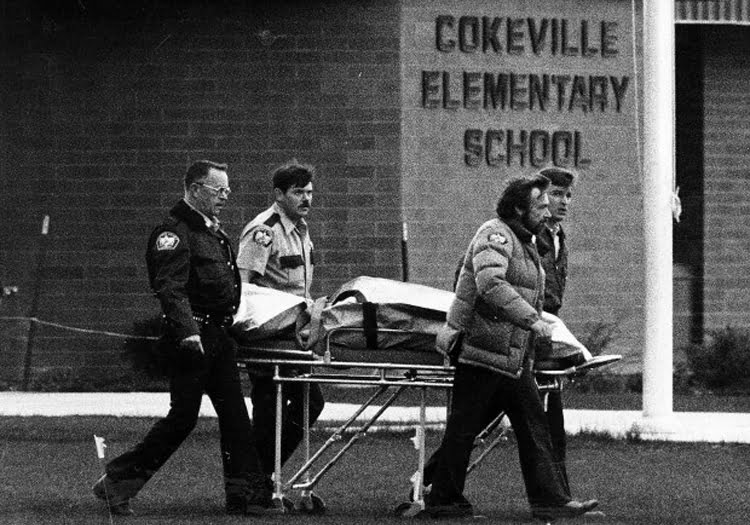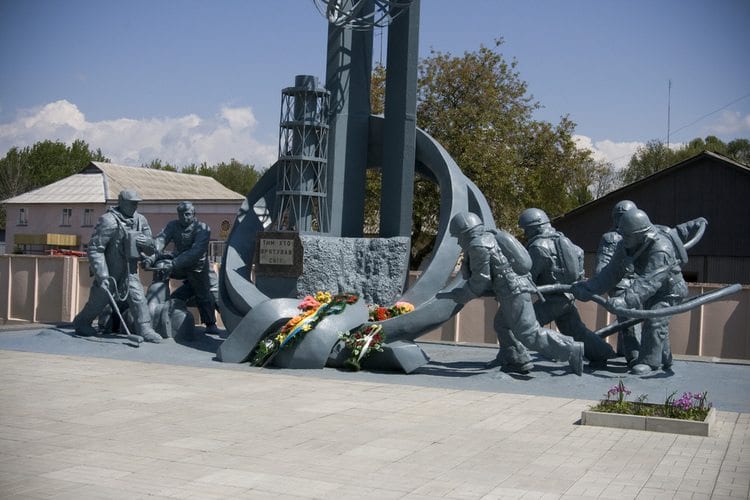On a sunny Friday afternoon in 1986, the unthinkable happened in the small town of Cokeville, Wyoming. Two people walked into the local elementary school and took the town’s children and teachers hostage. In that moment, the Mormon community of Cokeville’s trust was broken, but something far more extraordinary was about to happen. As a result, the events of that May 16th not only showed the dark depths of humanity – but also the bright potential of faith.
David Young was mentally troubled throughout his life, but, for a time, he was able to focus on his career. After earning a degree in criminal justice at Chadron State College in Nebraska, he was hired as Cokeville’s town marshal in the 1970s. During his six months in that position, he met and married local waitress and singer Doris Waters. Soon enough, though, he was dismissed from the position after a 6-month probationary period.
The newly married Youngs then left Cokeville for Tucson, Arizona. They had both been married before and had children – one daughter for Doris and two for David. As David’s youngest child, Penny, still lived with them, they quickly sought a new home in a trailer park. Doris took on part-time work as a housekeeper and waitress, but David became increasingly isolated. He began composing his philosophical manifesto, Zero Equals Infinity, in which he argued for a new world order or, as he called it, “A Brave New World.”
For David’s long-time friends Gerald Deppe and Doyle Menenhall, his treatise manifested as a get-rich-quick plan that he called “The Biggie.” What they did not know was that he was planning to take over Cokeville Elementary School and hold the children hostage for 2 million dollars each. David planned to negotiate with then-President Ronald Reagan before setting off a bomb that would take them all to a new world where he would reign supreme. He targeted the tight-knit community, noting in his journals: “Threaten one, and all are at your mercy.” However, what he took as a weakness would be Cokeville’s true strength.
In David’s writings, he explained that the imaginary world of Zero Equals Infinity felt like his and the Cokeville children’s last resort. However, Young clearly understood the nature of his planned crime, as he only revealed the plan to Deppe and Menenhall on the way to Cokeville Elementary. When they refused to participate, David held them at gunpoint while his daughter and wife handcuffed them inside their van.
Then, shortly after 1 PM, mother, father, and daughter abandoned the van and walked through the school’s front doors. They brought with them hundreds of copies of Zero Equals Infinity, 9 handguns, 4 rifles, and a gasoline bomb in a grocery cart with a shoelace trigger attached to David’s wrist. Upon entering, though, Penny hesitated and dashed back to the van to report her father’s plans at Cokeville Town Hall.
Meanwhile, at the school, David set up the bomb at the center of Classroom #4. Doris went room to room, gathering students and faculty with claims of a surprise assembly. Upon entering, many realized something was amiss, especially as David began distributing and reading from his manifesto. When authorities arrived, he demanded to speak to President Reagan, to whom he’d sent a copy of his manifesto, and then asked for the ransom.
Altogether, 154 people gathered in that claustrophobic, 30 by 32-foot room, including 136 children, 9 teachers, 6 staff, a job applicant, and a UPS driver. The heat of the summer day made the crowded room feel even smaller, and fumes from the gasoline bomb made everyone sick. As the dire nature of their situation became apparent, children began sobbing and complaining of headaches or wanting to go home. To keep the kids safe, the adults had a few windows opened and made an off-limits masking tape square around the bomb.
Teachers then got permission to bring in books, art supplies, games, and a television to keep the children calm. One student was celebrating their birthday, so everyone sang “Happy Birthday,” but it did not lift the mood. Doris even tried to soothe the students’ nerves by telling them to think of the day as a story or an adventure movie.
At the same time, parents and authorities gathered on the opposite side of the school. Tensions were running high, and many in the tiny classroom began to pray. At that point, David left to use the bathroom and entrusted the bomb to Doris. Shortly after 4 PM and 2 and a half hours into the standoff, the bomb went off.
Shortly after David went to the adjoining bathroom, Doris attempted to direct a student – and set off the bomb in the process. Teachers shouted for everyone to get down, and a dark cloud of black smoke filled the room as chaos ensued. Flames filled the room, with Doris on fire and several children burnt by the bomb. However, most had been sitting near the windows and doors, so teachers and staff began shoving students out of the room.
When David emerged, he shot his nearly-dead wife before shooting wildly into the surrounding smoke. In so doing, he only hit one person – music teacher John Miller, who’d been helping others escape. While severely injured, Miller would later recover. Young, on the other hand, suddenly retreated into the bathroom and shot himself dead.
Outside, parents surged at police lines to reach their children and shouted their names. Many reported not being able to recognize anyone, as the students were covered in black soot. Those closest to the bomb emerged with severe burns, and 79 total were taken to area hospitals. In the end, though, the only casualties were David and Doris Young.
As reporters converged on Cokeville, another story emerged. Investigators found that the bomb had been – perhaps miraculously – broken. Blasting cap wires had been cut before detonation, a gasoline leak prevented explosive powder from setting the air on fire, and, despite a great deal of shrapnel, no one had been hit. As a result, the blast, which should have leveled the entire wing, had gone straight up – and so minimized human harm.

At the same time, adults and children alike reported feeling embraced by a warm blanket while waiting in the classroom. The experience was especially intense for those who had prayed. Stories and drawings emerged of a beautiful woman in white who told children to sit by the windows, and several children saw angels with the face of a loved one over each person just before the blast. Others experienced divine intervention more directly:
- Jennie Sorensen Johnson reported a teacher helping her flee the burning classroom, only to recognize the figure much later in life as her long-dead great-aunt.
- Katherine Payne recalled her dead grandmother telling her to listen to her brother, who then instructed her to wait by the window shortly before the bomb blast.
- Even lead investigator Ron Hartley’s son pointed to an image of his grandmother as the angel who’d protected him in the fire.
Among these divine accounts, some even reported that the angels joined hands and forced the explosion upwards. In short, what could have been a tragedy had become a miracle. Rather than driving this community apart, the Young’s attack had only brought them closer together.
The bombing of Cokeville Elementary shook the small community to its core – and yet vibrated with the power of their Mormon faith. Since then, the story has become a local legend, with several variants emerging, including tales of an angelic outline in the shrapnel. From film and book adaptations to the Wyoming State Archive’s oral history project, “Survivor Is My Name,” what is clear is that this reprehensible attack only made the community all the stronger.
Source: http://www.theoccultmuseum.com/sinister-ghost-picture-ever-taken/
See this article also
BELOW: The incident was first detailed in the book The Cokeville Miracle: When Angels Intervene by Hartt Wixom and his wife Judene, published by Cedar Fort, Inc., which formed the basis for a CBS made-for-TV movie titled To Save the Children. In 2006, the Cokeville Miracle Foundation compiled a book of recollections about the day from parents, emergency workers and former hostages. The story was also featured on Unsolved Mysteries, Unexplained Mysteries, and I Survived… A movie about the incident, The Cokeville Miracle, was released on June 5, 2015. It was made by filmmaker T. C. Christensen and can be seen on Youtube.





